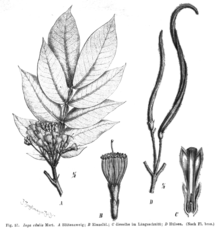Inga edulis
| Inga edulis | ||||||||||||
|---|---|---|---|---|---|---|---|---|---|---|---|---|

Inga edulis , leaves and inflorescences |
||||||||||||
| Systematics | ||||||||||||
|
||||||||||||
| Scientific name | ||||||||||||
| Inga edulis | ||||||||||||
| Mart. |
Inga edulis is a type of plant from the subfamily of the mimosa family (Mimosoideae) within the legume family (Fabaceae). The originally Neotropical distribution extends from Mexico south to Central and South America. It is a neophyte in many tropical countries. Synonyms are Joaquiniquil (South America), cuaniquil (Mexico), guama, ice-cream bean (English).
description
The Inga edulis grows as a smaller, evergreen tree that can reach heights of over 15 meters. The broadly spreading treetop is richly branched. The trunk diameter reaches up to 60 centimeters. The relatively smooth bark is gray-brown and slightly rough to scaly. The cylindrical trunk is usually twisted and branches from 1 to 2 meters above the ground.
The 10 to 30 cm long leaves are pinnate in pairs and alternate. Four to six pairs of leaflets are arranged on a short-winged rhachis . The leathery, elliptical to obovate and entire-margined leaflets are up to 15 cm long and up to 8 cm wide. At the top they are pointed to pointed. The underside of the leaflet is short and hairy. The small stipules fall off early. There may be glands on the leaf hachis.
At the ends of the branches are terminal or axillary from February to May, the 2 to 6 cm long stalked, doldig -headed inflorescences or the flowers appear tufted together. The elongated-lanceolate bracts with a length of about 5 mm fall off when they open. The sedentary, fragrant and hermaphrodite, tubular, greenish-white flowers are zygomorphic with a double flower envelope . The downy, hairy, tubular fused sepals are striped and 5 to 8 mm long. The tubular fused and silky hairy petals are 14 to 20 mm long. There are many long stamens that are fused together in the lower part . The ovary is on top with a long stylus .
With a length of up to 0.5–2 m and a diameter of 2 to 4 cm, the very long and sometimes twisted, square, slightly hairy, non-opening and pointed, laterally flattened legume has strongly thickened, furrowed edges. A white pulp surrounds the seeds. The fruits ripen several months after fertilization.
The number of chromosomes is 2n = 26.
Systematics
The name Inga edulis was first published in 1837 by Carl Friedrich Philipp von Martius in Flora , 20 (2), Beibl., Pp. 113-114. Synonyms for Inga edulis Mart. are: Feuilleea edulis (Mart.) Kuntze , Inga benthamiana Meissner , Inga scabriuscula Benth. , Inga vera sensu Brenan , Inga vera Kunth , Inga ynga (Vell.) JWMoore , Mimosa ynga Vell.
Use and folk medicine
Inga edulis are grown in tropical areas. The pulp is eaten directly from the legumes or it is processed into sweet desserts. In Central and South America, Inga edulis trees are planted as shade trees in cocoa, coffee, tea and vanilla plantations . They can be found in parks and avenues, especially at low altitudes. They improve the soil quality and prevent erosion. Colombian indigenous peoples brew an alcoholic drink called "cachiri" from the arillus . Half of the Choco Indians in Panama cultivate Inga edulis near their homes.
Almost all Colombian Inga species are used in folk medicine .
literature
- Food and fruit-bearing forest species. 3: Examples from Latin America. FAO Forestry Paper 44/3, FAO, 1986, ISBN 92-5-102372-7 , p. 161 ff.
- Datasheet at Purdue (Section Description, Dissemination, Use and Folk Medicine).
Web links
- Inga edulis at Useful Tropical Plants.
Individual evidence
- ^ Inga edulis at Tropicos.org. In: IPCN Chromosome Reports . Missouri Botanical Garden, St. Louis
- ^ Entry at ILDIS - International Legume Database & Information Service.
- ^ Inga edulis at Tropicos.org. Missouri Botanical Garden, St. Louis

